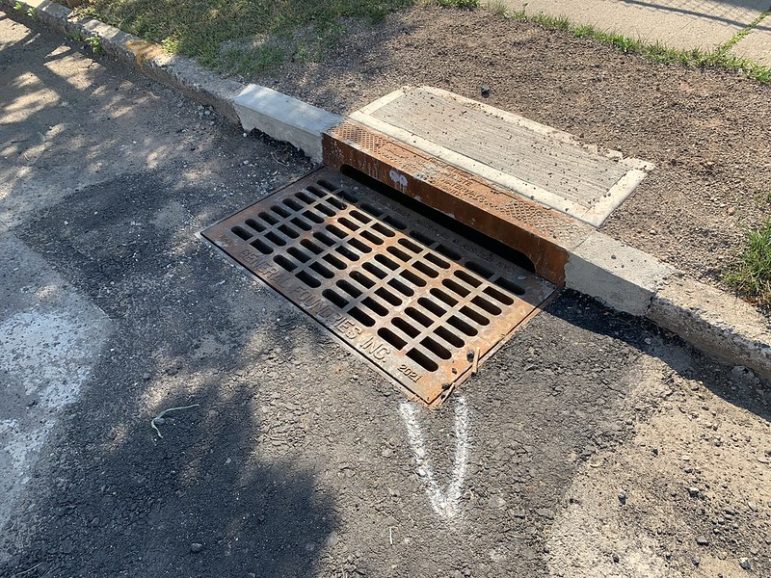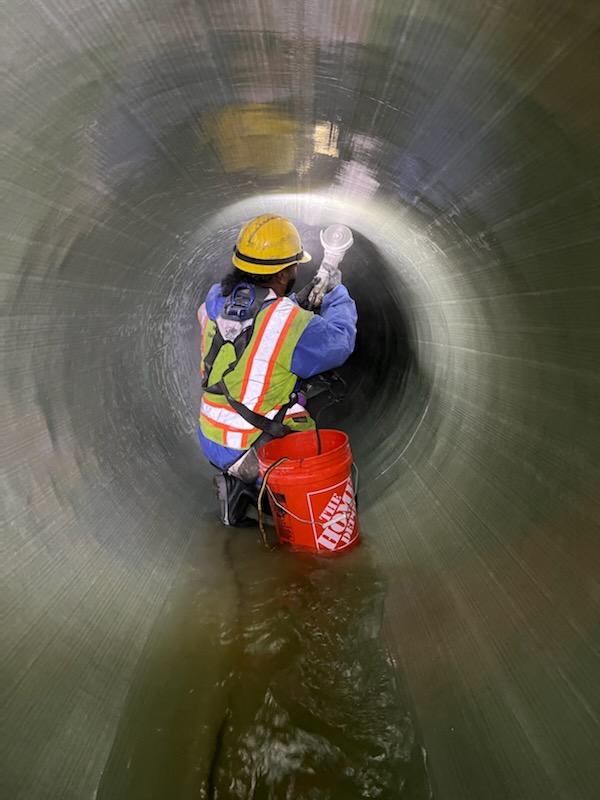The city’s aging infrastructure combined with more intense rainfall is resulting in more sewer backups, which took on average more than 15 hours to resolve during the last fiscal year that ended in June.

NYC Water/NYC DEP
A sewer and catch basin in Staten Island.The increased intensity and frequency of storms over the past year led to a spike in sewer backups across the city and major delays in resolving them, according to the latest Mayor’s Management Report.
The report, released last week, showed that the number of confirmed sewer backups nearly doubled in the last year, from 1,983 incidents in fiscal year 2021 to 3,773 in 2022. The time it took the city’s Department of Environmental Protection (DEP) to resolve those backups spiked even more dramatically—from an average of 2.7 hours in 2021 to 15.5 hours in 2022.
The cause? “Climate change,” said a spokesperson with the DEP. Extreme weather events broke 50-year records for rainfall twice last summer alone, causing a disruption across the city’s aging sewer system.
In August 2021, tropical storm Henri set a record for the most intense rainfall the city has ever experienced and led to 50 percent more backups than usual.
The next month, Ida broke that record by dumping over three inches of rainfall in an hour—double the previous record before Henri, which was set in 1967. Ida caused reports of sewer backups to increase six times that month alone, DEP said. Responding to those reports took, on average, a day and a half.
“The more intense storms that climate change is bringing to the five boroughs overtaxed the City’s drainage infrastructure and caused a significant increase in sewer backups,” the DEP said in a statement.
In an oversight hearing on infrastructure in August, DEP Commissioner Rohit Aggarwala explained that sewer standards, which have been set by the DEP since the agency was created in the 1970s, were previously determined by each borough president. In Queens, sewers can handle up to 1.5 inches of rain, less than the overall city’s capacity of 1.75 inches. And over 100 years ago, city officials in The Bronx used a sewer construction material that, although revolutionary at the time, weakens under pressure from such intense rainfall.
“That sewer’s particular combination of materials and design was not appropriate to a world in which the sewer would be full and pressurized on a regular basis—which is what the last 12 months’ many extreme storms have done,” Aggarwala testified to the Council.
The result is not only increased backups, but also street cave-ins, which have increased nearly 40 percent in the last year. In July, a massive sinkhole in The Bronx stretching 58 feet long and 20 feet deep swallowed a van and led to street closures for over a month (the repair work was completed the week of Labor Day, the DEP said.)

NYCDEP
DEP crews are adding liners to fortify sewers in The Bronx near where a large sinkhole emerged this summer.That incident was after the DEP and Department of Transportation took new measures in recent years to address underlying infrastructure issues following sinkhole incidents, including adding a concrete base to backfill as a way to prevent future cave-ins, and to create an interagency working group that reviews any cave-ins close to utility lines, according to the DOT.
Crews are currently adding internal liners to the sewers in that area to prevent future incidents, the DEP added.
“Extreme storms like Ida gain intensity quickly,” said Aggarwala. “And because we cannot change our infrastructure as quickly as the climate is changing, New Yorkers cannot be as confident as before that our infrastructure will function as reliably as we expect in extreme conditions.”
Liz Donovan is a Report for America corps member.









3 thoughts on “Sewer Backups Nearly Doubled in NYC Last Year Due to Climate Change”
Sewer backups are greatly aggravated by the tonnage of litter and other trash that is left on the streets. An enforced anti-littering law and a big advertising campaign to geberate public awareness and sympathy for cleaner streets and waterways would go a long way toward ameliorating the problem. An anti-littering culture has to be created.
I live in Wakefield, near the MTA rail yard for the 2 and 5 trains. We finally had our street sewer line cleaned a couple of months ago after intervention by our council member. One longtime homeowner is so frustrated by repeated backups that she told me she “will just walk away” after the next one.
Because of outdoor eating structures, bike lanes and illegal parking, I never see street sweepers anymore.
As a result the street drains are usually covered with piles of garbage, leaves and food containers.
This ends up in drain and causes flooding.
Who is supposed to clean the drains? The businesses?